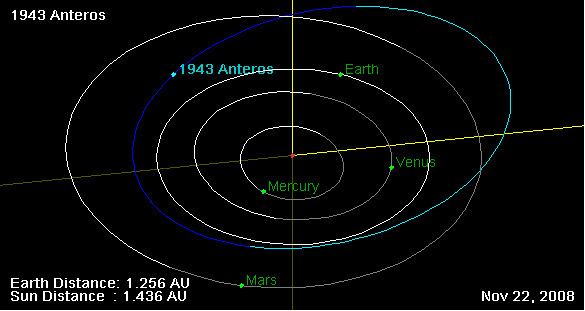Discovered by J. B. Gibson Minor planet category Amor · NEO Discovered 13 March 1973 Discoverer James B. Gibson | Discovery date 13 March 1973 Alternative names 1973 EC Observation arc 43.74 yr (15,976 days) Orbits Sun | |
 | ||
Similar Sun, 1627 Ivar, 1980 Tezcatlipoca, 1221 Amor, 1580 Betulia | ||
1943 anteros 1973 ec
1943 Anteros, provisional designation 1973 EC, is a spheroidal, rare-type asteroid and near-Earth object, approximately 2 kilometers in diameter. It was discovered on 13 March 1973, by American astronomer James Gibson at the Leoncito Astronomical Complex in Argentina.
Anteros is a member of the Amor group of asteroids, which approach the orbit of Earth from beyond but do not cross it. It orbits the Sun at a distance of 1.1–1.8 AU once every 1 years and 9 months (625 days). Its orbit has an eccentricity of 0.26 and an inclination of 9° with respect to the ecliptic. Anteros has an Earth minimum orbit intersection distance of 0.0625 AU (9,350,000 km) or 24.3 lunar distances, which is slightly above the defined limit of 0.05 AU for potentially hazardous objects. The body's observation arc begins 3 days prior to its official discovery observation in 1973, as a 1968-precovery from Palomar remained unused.
In the SMASS taxonomy, Anteros is a relatively rare L-type asteroid described as a reddish, but otherwise featureless stony asteroid. It is also classified as a Sq subtype asteroid.
Several rotational light-curves of Anteros were obtained from photometric observations by Brian D. Warner, Petr Pravec, the Palomar Transient Factory and others since the 1980s. One of the best-rated and most recent light-curves was obtained at the U.S. Palmer Divide Station in December 2013, and gave a rotation period of 2.867 hours with a brightness variation of 0.1 magnitude, which indicates that Anteros has a nearly spheroidal shape (U=3).
According to the EXPLORENEOs survey carried out by the Spitzer Space Telescope, Anteros measures between 2.38 and 2.43 kilometers in diameter, and its surface has an albedo of 0.138 to 0.170. The Collaborative Asteroid Lightcurve Link assumes an albedo of 0.18, and derives a diameter of 2.0 kilometers based on an absolute magnitude of 15.89.
The asteroid was named after the Greek god Anteros, avenger of unrequited love and punisher of those who scorn love and the advances of others. The asteroid's name may have been chosen because its orbit is similar to the asteroid 433 Eros, and in Greek mythology, Anteros was said to be the twin brother of Eros. Naming citation was published before November 1977 (M.P.C. 4237).
